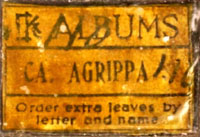 Agrippa (a book of the dead) appeared in 1992 as a collaboration between artist Dennis Ashbaugh, author William Gibson, and publisher Kevin Begos, Jr. The Agrippa Files is a scholarly site that presents selected pages from the original artist’s book; a unique archive of materials dating from the book’s creation and early reception; an emulation of Gibson’s included poem in its original born-and-die-digital form (it ran from a diskette once before an encryption-like effect made the diskette unrunnable); analysis of the code on the diskette resulting from a 2012 hacker’s contest; a simulation of what the book’s intended “fading images” might have looked like; a video of the 1992 “transmission” of the work; a “virtual lightbox” for comparing and studying pages; full-text scholarly essays and interviews; an annotated bibliography of scholarship, press coverage, interviews, and other material; a detailed bibliographic description of the book; and a discussion forum. (continued…)
Agrippa (a book of the dead) appeared in 1992 as a collaboration between artist Dennis Ashbaugh, author William Gibson, and publisher Kevin Begos, Jr. The Agrippa Files is a scholarly site that presents selected pages from the original artist’s book; a unique archive of materials dating from the book’s creation and early reception; an emulation of Gibson’s included poem in its original born-and-die-digital form (it ran from a diskette once before an encryption-like effect made the diskette unrunnable); analysis of the code on the diskette resulting from a 2012 hacker’s contest; a simulation of what the book’s intended “fading images” might have looked like; a video of the 1992 “transmission” of the work; a “virtual lightbox” for comparing and studying pages; full-text scholarly essays and interviews; an annotated bibliography of scholarship, press coverage, interviews, and other material; a detailed bibliographic description of the book; and a discussion forum. (continued…)
The artist’s book Agrippa (a book of the dead) (New York: Kevin Begos Publishing, 1992) originally appeared in a deluxe limited edition (and cancelled small-format edition) that is today publicly available only in a handful of rare book rooms and museums.
Agrippa has a disk buried in its last pages. That disk, which contains the 305-line text of Gibson’s memory poem about his father and his own youth (captured for reflection by the “mechanism” of a camera and a 1920 Kodak “Agrippa” brand photo album), scrolls its text up the screen once before an encryption-like effect makes it seem to vanish, locking it up from all but determined hackers. Similarly, the found-art advertisements of television sets, phones, guns, and other objects related to the poem that Ashbaugh printed over his distinctive copperplate aquatint etchings alluding to DNA gels or stains were also intended to vanish (though in the end there was no way technically to implement the idea). (See emulation of the original software for Gibson’s poem running from its diskette and digital simulation of Ashbaugh’s fading ink effect.)
Meanwhile, the Internet was growing, and 1992—the birth year of the first graphical Web browser, Mosaic—was its witching hour. What “cyberspace” saw in Agrippa was like the missing photo album—the Blade Runner-like replicant memory—of its own childhood. It saw a missing link between the codex book and the new digital medium. Or, again, it saw an allegory for the dynamic, transient, and random-access potential of cyberspace that from the viewpoint of print seemed like so much vanishing ink. It saw Gibson’s and Ashbaugh’s memory book, in other words, as a prophecy of RAM.
Throughout 1992, BBS’s and email furiously churned with rumors about the coming Agrippa, Gibson’s “novel” (as it was sometimes mistakenly described), and its so-called encryption “virus” (which John Perry Barlow of the Electronic Frontier Foundation feared might earn the work unwanted attention at the exact moment when the U.S. government was legislating encryption). And a December 1992 electronic “transmission” of live readings and images of Agrippa to multiple locations—a kind of “happening” for the wired—increased the buzz. Print journalists were also fascinated, spinning out much press about the book.
Today, Agrippa is in danger of being erased by its own legend. Early on, Gibson’s poem was leaked onto the Internet to flourish in innumerable ghostly copies. And scholars began to discuss and teach the work. But during all this time, almost no one actually saw the book, which thus vanished behind all the memes about its conceptual art of vanishing. Even Gibson has at times doubted the existence of the concrete artifact, inscribing it into a kind of is-it-there-or-not? myth of pattern recognition.
The Agrippa Files is a scholarly site designed to make the published book and its accompanying ephemera of documents, images, software, and reception history more accessible.
